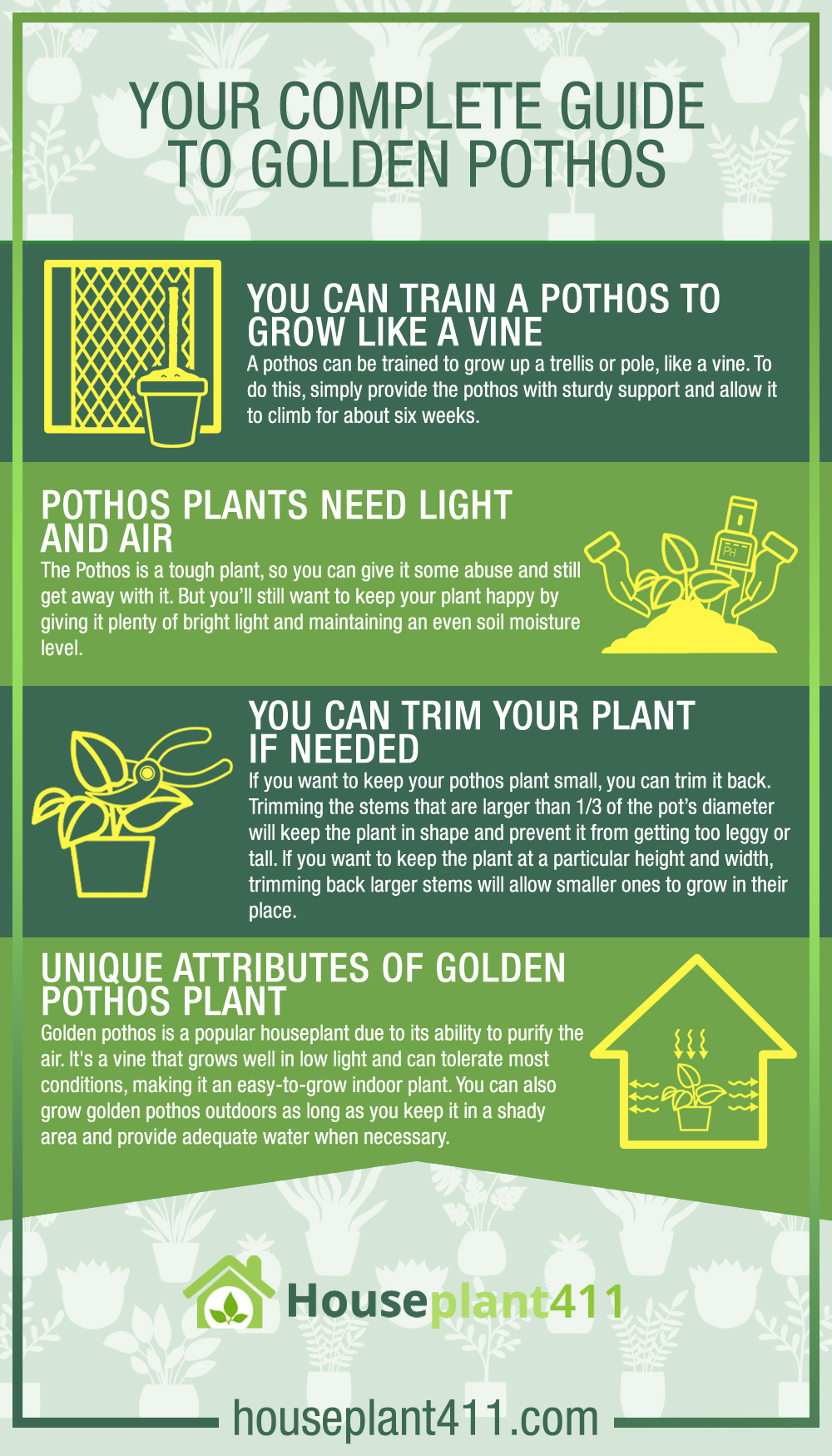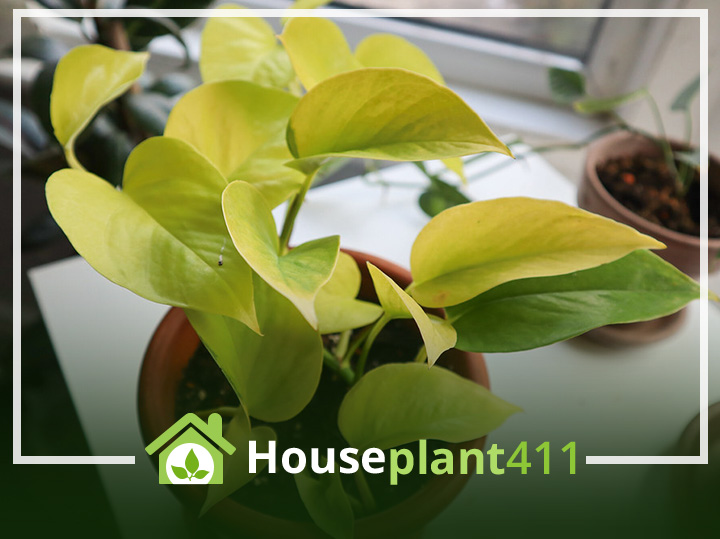The Golden Pothos is one of the most popular indoor plants, known for its large leaves and ease of care. It’s often mistakenly called the pothos plant or devil’s ivy, among other names. The Golden Pothos is a gorgeous plant that looks great in any room, and people often place it in hanging baskets or on shelves.
You can also train a pothos to grow up a trellis or pole, like a vine. If you want to keep your pothos plant small, you can trim it back regularly as needed—just be sure not to cut off too much at once since this will lead to new growth coming in at different rates around your plant rather than uniformly along stems.
In this article, we look at Golden Pothos and study a detailed guide on how to care after one. Stay with us as we take you through our guide.
What is the Golden Pothos?
The Golden Pothos is one of the most popular indoor plants, known for its large leaves and ease of care. Golden Pothos (Epipremnum aureum) is a member of the Araceae family and an easy-to-grow houseplant. It is a vine plant that can grow up to 10 feet long, with heart-shaped leaves that are green with yellow or white stripes. The leaves are arranged oppositely on the stem and have pointed tips. The roots of this plant grow from nodes along its rhizome, which adds length to it as well as stability in hanging baskets or pots filled with soil.
In tropical areas (or places with very warm climates), pothos will grow outside in full sun. But in cooler areas it grows best in partial shade to bright indirect light.
These plants are hardy and adaptable to almost any home environment. They’re great indoor plants because they’re easy to care for and look beautiful on a desk or table top throughout the year—even when you forget about them!
It’s often mistakenly called the pothos plant or devil’s ivy, among other names. The golden pothos is a common name that many people use to refer to the plant. Other names include devil’s ivy, mother-in-law’s tongue, and philodendron. Pothos is a climbing plant that can grow up to 10 feet tall and 6 feet wide.
You can Train a Pothos to Grow like a Vine
A pothos can be trained to grow up a trellis or pole, like a vine. To do this, simply provide the pothos with sturdy support and allow it to climb for about six weeks.
- First, make sure that your trellis or pole is strong enough to support the weight of your plant. The diameter should be at least 3 inches (7.6 cm) in diameter and 6 feet (1.8 m) tall.
- Next if you are using string or wire, run one end through an eye screw or staple it into place on two sides of your trellis/pole so it hangs freely between them when tautly strung between those points in an arch shape above where you want your plant growing against it vertically upwards towards its leaves being exposed towards sunlight as much as possible without being disturbed by wind or falling debris caused by storms etcetera which may damage fragile new growths on top side branches unable to stand up straight due lack thereof yet strong enough later down below having been twisted back around itself wrapped tightly away from light and air circulation preventing it from drying out and dying.
- Securely attach your pothos plant to the stake with a piece of wire or string, making sure it’s in an upright position and not leaning over too much toward one side or another. The idea here is for your plant to grow vertically, not horizontally!
Pothos Plants Need Light and Air
The Pothos is a tough plant, so you can give it some abuse and still get away with it. But you’ll still want to keep your plant happy by giving it plenty of bright light and maintaining an even soil moisture level.
Watering a pothos is simple. When the soil feels dry to the touch, give the plant a good soak by filling up a bucket and then letting the water run through your fingers until they’re at least damp but not dripping wet. Then use that same hand to lightly pat down any soil around the base of each stem—you don’t want too much water pooling in one spot or else this could lead to root rot or other issues.
Don’t overwater! If roots are sticking out from pots or hanging out of drainage holes when you water them, then there’s probably too much moisture in that pot for now; wait for those roots to start growing back into their container before watering again (this will typically take anywhere from 1 – 2 weeks). And finally: don’t let pothos plants sit in standing water when you’re done watering them—this will cause their roots to rot away quickly due to lack of oxygenation!
You can Trim Your Plant if Needed
If you want to keep your pothos plant small, you can trim it back. Trimming the stems that are larger than 1/3 of the pot’s diameter will keep the plant in shape and prevent it from getting too leggy or tall. If you want to keep the plant at a particular height and width, trimming back larger stems will allow smaller ones to grow in their place. If you notice that your pothos is growing out of its container, trimming back some of its roots may help ease it into a larger size pot or outdoor planting site.
Trimming should be done when new growth begins in spring—this allows time for any branches cut during trimming to recover before they begin producing more leaves.
So, you’re looking for a plant that’s easy to care for and will provide you with years of beauty and greenery? The Golden Pothos could be the perfect fit.
This vine is known for being hardy and fast-growing, so it’s a popular plant in homes and offices around the world. It also happens to be among one of the easiest plants to grow indoors without any special effort on your part—so if you’re just getting into gardening, this may be your best bet!
When it comes down to it though, there’s really no reason not to have this lovely houseplant in your home or office.
Unique Attributes of Golden Pothos Plant
Golden pothos is a popular houseplant due to its ability to purify the air. It’s a vine that grows well in low light and can tolerate most conditions, making it an easy-to-grow indoor plant. You can also grow golden pothos outdoors as long as you keep it in a shady area and provide adequate water when necessary.
Golden pothos plants originate from India, Myanmar and Sri Lanka. They are widely grown all over the world for their beauty, but they’re especially useful for their ability to purify indoor air pollution by removing harmful toxins like formaldehyde from your home environment without using any electricity or chemicals!
The Golden Pothos has been used for centuries by people who live in tropical areas for medicinal purposes, such as treatments for dengue fever and malaria. However, there is no scientific research showing any evidence that supports these claims about its healing powers!
Golden Pothos is a plant that is also known as the Devil’s Ivy and is a member of the Araceae family of plants. It is a vine that can grow up to 15 feet long, but it usually stays between 3 and 5 feet long.

Tips for Taking Care of Golden Pothos
Golden pothos is a popular houseplant that’s easy to care for and can grow up to 10 feet high. It’s a good plant to have around because it purifies the air in your home and helps eliminate toxins like formaldehyde and benzene.
Water the Plant With Room-Temperature Water
Water the plant with room-temperature water. Watering pothos with cold water will cause the leaves to turn yellow. Watering it with warm or hot water will cause the leaves to turn brown. You can also mist the plant by following the tips below:
- Use room-temperature water and a spray bottle or mister to mist the plant, then wait about three minutes for water to absorb into the soil before moving on to the next step.
- Mist every day or every other day as needed, depending on how dry your house is and how much natural light it receives each day. Don’t forget that direct sunlight can be more intense than you might expect!
- If you notice your plant starting to wilt or droop in any way, increase misting frequency until its leaves are hydrated again—but don’t overwater (see #4).
Ensure It Has Sufficient Light, but Don’t Expose It to Direct Sun
Pothos is a plant that thrives in low light. It’s also a tropical plant, so it needs lots of light. It’s important to ensure your golden pothos gets enough light to grow, but not so much that it burns or dries out its leaves.
If you have a window where your pothos will get bright, indirect light all day long, then this might be the best place for your plant. If you don’t want to put it in front of any windows or near artificial lights (like lamps), another option is to find an area near a south-facing window where the plant can receive plenty of natural sunlight during the day and still stay cool at night—but make sure there isn’t anything blocking that area from getting direct sunlight before placing your golden pothos there!
Keep the Plants Away From Cold Drafts
Keep the plants away from cold drafts. Golden pothos thrive in warm areas, but they can withstand some cooler temperatures as long as they aren’t exposed to direct drafts. If your potting area is drafty and you keep your golden pothos there, the leaves will turn brown quickly and may even fall off. This won’t kill your plant, but it won’t grow well either!
Avoid Over Watering the Plant
Avoid over-watering them by checking for soil dampness before watering and making sure they have a drainage hole to prevent root rot.
Golden pothos plants are easy to care for and good for beginners, but they can be prone to root rot if they’re over-watered. The best way to prevent this is by checking the soil before watering your plant. Squeeze a handful of it between your fingers—if it feels dry, give your plant some water until the soil is damp all the way through. If the topmost inch of soil feels wet or soggy, don’t give it any more until its roots have dried out and their moisture content has equalized with that of the lower levels again.
Golden pothos do not have drainage holes in their pots by default, so if you find that yours does not contain one (or if you’re using a pot without one), make sure there’s a place where excess water can drain away from its roots by adding rocks or gravel on its bottom surface before placing them into an appropriate container with drainage holes in its bottom layer instead. We hope you’ve found this information useful.

If you’re thinking about planting a Golden Pothos in your home, or if you want to know more about it, we encourage you to contact us at The Golden Pothos Company. We’d be happy to answer any questions you have and supply some tips on how best to care for this beautiful plant!

